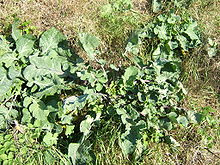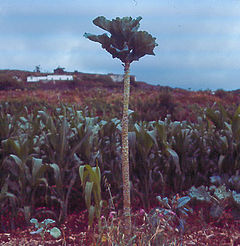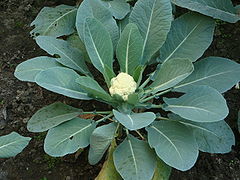- Brassica oleracea
-
Brassica oleracea 
Wild Cabbage plants Scientific classification Kingdom: Plantae (unranked): Angiosperms (unranked): Eudicots (unranked): Rosids Order: Brassicales Family: Brassicaceae Genus: Brassica Species: B. oleracea Binomial name Brassica oleracea
L.Brassica oleracea, or wild cabbage, is a species of Brassica native to coastal southern and western Europe, where its tolerance of salt and lime and its intolerance of competition from other plants typically restrict its natural occurrence to limestone sea cliffs, like the chalk cliffs on both sides of the English Channel.
Wild B. oleracea is a tall biennial plant, forming a stout rosette of large leaves in the first year, the leaves being fleshier and thicker than those of other species of Brassica, adaptations to store water and nutrients in its difficult growing environment. In its second year, the stored nutrients are used to produce a flower spike 1 to 2 metres (3–7 ft) tall bearing numerous yellow flowers.
Contents
Cultivation and uses
B. oleracea has become established as an important human food crop plant, used because of its large food reserves, which are stored over the winter in its leaves. It is rich in essential nutrients including vitamin C. Although it is believed to have been cultivated for several thousand years, its history as a domesticated plant is not clear before Greek and Roman times, when it was a well-established garden vegetable. Theophrastus mentions three kinds of rhaphanos (ῤάφανος):[1] a curly-leaved, a smooth-leaved, and a wild-type.[2] He reports the antipathy of the cabbage and the grape-vine, for the ancients believed that cabbages grown near grapes would impart their flavour to the wine.[3] It has been bred into a wide range of cultivars, including cabbage, broccoli, cauliflower, and more, some of which are hardly recognisable as being members of the same genus, let alone species. The historical genus of Crucifera, meaning four-petalled flower, may be the only uniting feature beyond taste.
Origins
According to the Triangle of U theory, B. oleracea is very closely related to five other species of the genus Brassica.[4]
The cultivars of B. oleracea are grouped by developmental form into seven major cultivar groups, of which the Acephala ("non-heading") group remains most like the natural Wild Cabbage in appearance:
- Brassica oleracea Acephala Group – kale and collard greens
- Brassica oleracea Alboglabra Group – Chinese broccoli
- Brassica oleracea Botrytis Group – cauliflower, Romanesco broccoli and broccoflower
- Brassica oleracea Capitata Group – cabbage
- Brassica oleracea Gemmifera Group – brussels sprouts
- Brassica oleracea Gongylodes Group – kohlrabi
- Brassica oleracea Italica Group – broccoli
For other edible plants in the family Brassicaceae, see cruciferous vegetables.
In places such as the Channel Islands and Canary Islands where the frost is minimal and plants are thus freed from seasonality, some cultivars can grow up to 3 meters tall. These "tree cabbages" yield fresh leaves throughout the year, and harvest does not mean the plant needs to be destroyed as with a normal cabbage. Their woody stalks are sometimes dried and made into walking sticks.[5]
 Cabbage can be cultivated to grow quite large in frost-free climates like this tree cabbage in the Canary Islands.
Cabbage can be cultivated to grow quite large in frost-free climates like this tree cabbage in the Canary Islands.
Some (notably brussels sprouts and broccoli) contain high levels of sinigrin which may help prevent bowel cancer[citation needed].
References
- ^ Compare Theophrastus; raphanis (ραφανίς), "radish", also a Brassica.
- ^ Daniel Zohary and Maria Hopf, Domestication of plants in the Old World, third edition (Oxford: Oxford University Press, 2000), p. 199.
- ^ Theophrastus, Enquiry into Plants, IV.6.16; Deipnosophistae, I, noting the effects of cabages on wine and wine-drinkers, also quotes Apollodorus of Carystus: "If they think that our calling it a rhaphanos, while you foreigners call it a krambê, makes any difference to us women!" (on-line English text).
- ^ Dixon, G.R. (2007), Vegetable brassicas and related crucifers, Wallingford: CABI, ISBN 9780851993959
- ^ Williams, Paul H.; Hill, Curtis B. (June 13, 1986), "Rapid-Cycling Populations of Brassica" (pdf), Science, New Series (American Association for the Advancement of Science) 232 (4756): 1385–1389, doi:10.1126/science.232.4756.1385, PMID 17828914, http://www.bio.unc.edu/Courses/2008Fall/Biol423L/Pdfsforwebpage/Science86WilliamsFastPlants.pdf
External links
- PROTAbase on Brassica oleracea (Brussels sprouts)
- PROTAbase on Brassica oleracea (cauliflower and broccoli)
- Video Overview of Brassica oleracea: from Untamed Science
Categories:
Wikimedia Foundation. 2010.


